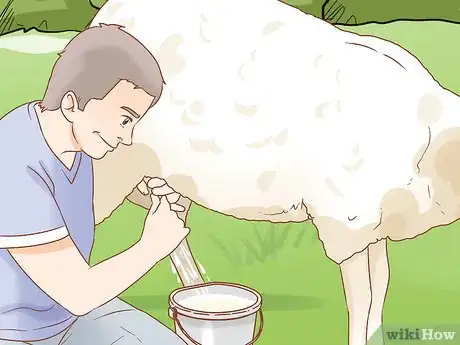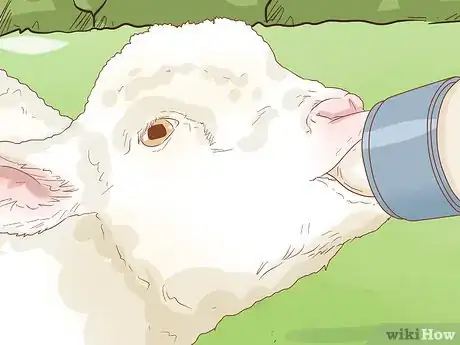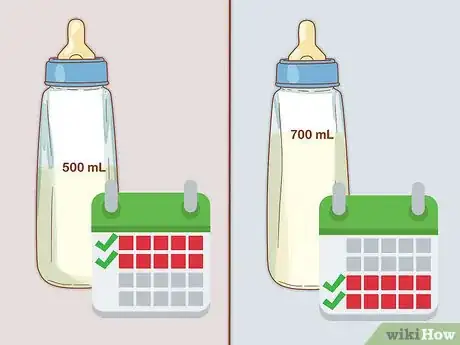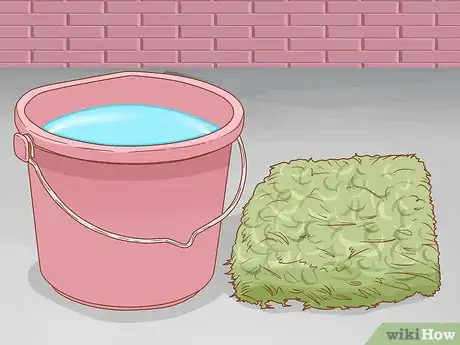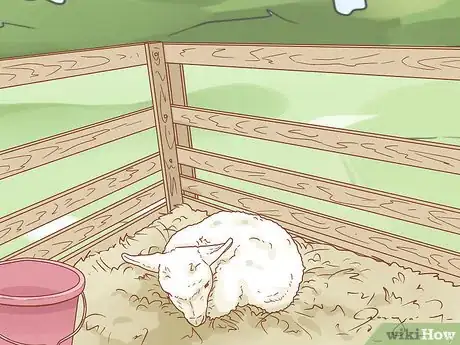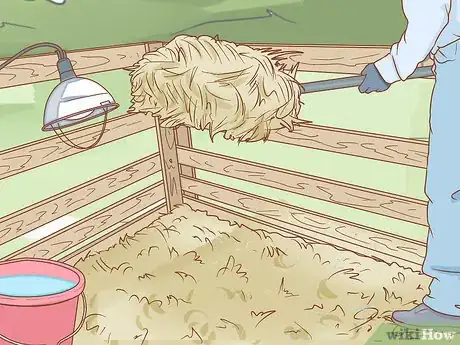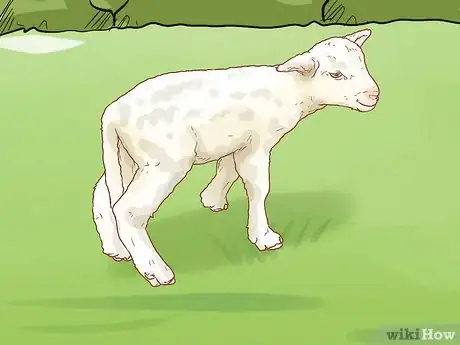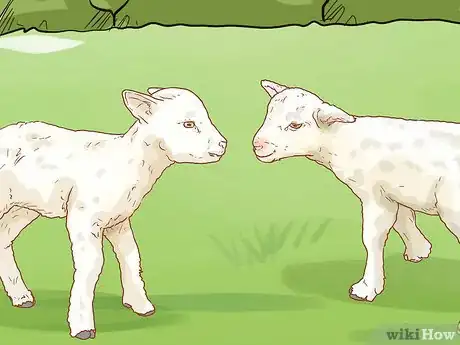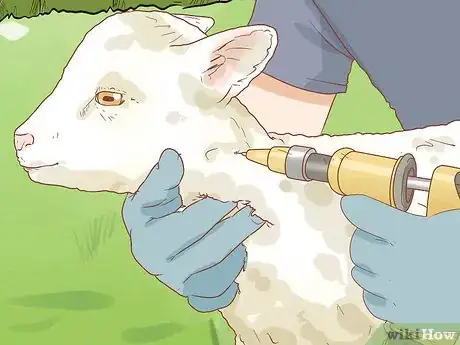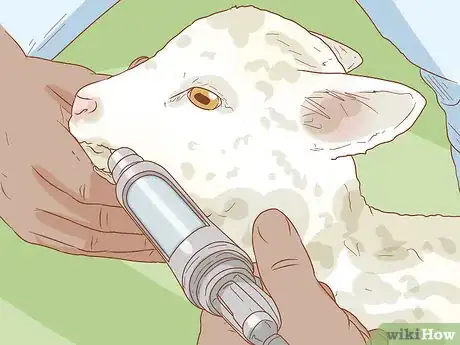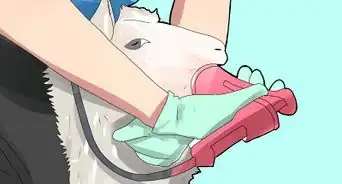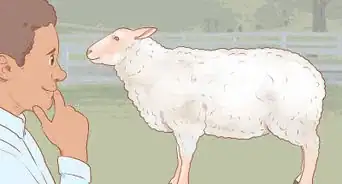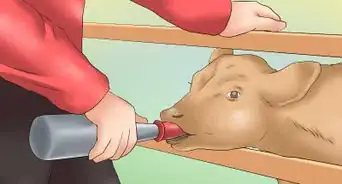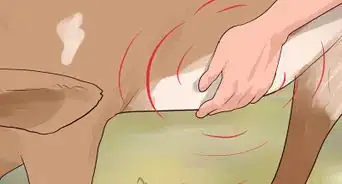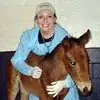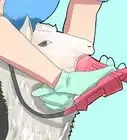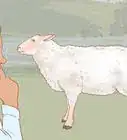This article was co-authored by Ryan Corrigan, LVT, VTS-EVN. Ryan Corrigan is a Licensed Veterinary Technician in California. She received her Bachelor of Science in Veterinary Technology from Purdue University in 2010. She is also a Member of the Academy of Equine Veterinary Nursing Technicians since 2011.
wikiHow marks an article as reader-approved once it receives enough positive feedback. In this case, 91% of readers who voted found the article helpful, earning it our reader-approved status.
This article has been viewed 95,828 times.
Raising an orphaned lamb can be a fun learning experience. You get to watch an animal grow and develop due to your efforts. However, it is also a lot of responsibility. You will be responsible for every part of their care, including feeding it, caring for its health, and making sure that it has all of its other needs met.
Steps
Feeding an Orphaned Lamb
-
1Get the lamb some colostrum. As soon as a lamb is born, it should drink a large amount of colostrum, which is the first milk that comes from mother sheep after birth. It is unlike normal milk because it is full of protein, fats, and antibodies that help a lamb thrive. Getting your lamb to drink colostrum should be a priority immediately after birth.[1]
- Colostrum from other sheep or cows can be given to lambs. If you can get fresh or frozen colostrum that is ideal. Supplements are typically available at farm supply stores or websites but are considered less effective.
- Your lamb should have about 500 milliliters (17 fl oz) of good quality colostrum over the first day of its life. This should be fed over the course of 6 to 8 feedings.
- Ask a veterinarian who is knowledgeable about caring for sheep how much colostrum to give per feeding. Your veterinarian may also be able to tell you where to get colostrum, such as some local farms that have some stored up.
- If you get frozen colostrum, make sure that you thaw it out in hot to warm water. Do not microwave the colostrum because this can damage the antibodies and proteins in it.
-
2Teach the lamb to drink from a bottle. Have the lamb stand up with its head up. Slowly put the nipple of the bottle in the lamb's mouth and move the lamb's jaw up and down in order to press the nipple together so that milk comes out. After about three or four times of opening and closing the animal's jaw, the lamb should catch on and suck regularly.
- If your lamb does not catch on, you should consult with a veterinarian. They may suggest the use of a feeding tube if your lamb is in desperate need of nutrition.
- You can test your lamb’s suckle reflex with your finger. If you offer your finger to the lamb, he should try to latch onto your finger and have a moderate to strong desire to nurse on your finger.
- If your lamb doesn’t have a strong suckle reflex, then consult a veterinarian. Do not attempt to bottle feed a lamb that can’t suckle. The lamb may end up inhaling some of the milk instead of drinking it.
Advertisement -
3Feed the lamb milk replacement. Once the lamb has drunk colostrum for the first day of its life, you can switch to milk replacement. The lamb will need to begin by drinking 140mL of milk replacement every four hours.
- Milk replacement can be obtained from your local feed store or ordered from a livestock supply website. Be sure to follow instructions on the replacement container, as some brand's mixing instructions differ from others.
-
4Increase the amount of milk replacement the lamb drinks gradually. Over the course of the first couple weeks, gradually increase the amount it eats to 500mL every four hours. Feed that much to the lamb for two weeks and then increase the amount you feed it again, to 700mL three times a day for two weeks.[2]
- After that, you can begin reducing the amount of milk replacement you are giving the lamb, down to 500mL twice daily.
-
5Introduce hay, grass, and water. When the lamb is several weeks old you can begin giving it access to grass, hay, and water. As the lamb begins to eat these things, you will be able to wean it off of milk replacement.[3]
- Once the lamb is over a month old, you should be reducing its milk intake. By the time it is three months old it should be totally weaned.
Caring for a Lamb's Basic Needs
-
1Give the lamb shelter. A motherless lamb is less likely to survive in part because it could get hypothermia from the elements. It will not have a mother to get shelter from at night, so you will need to supply some.
- Give the lamb access to a pen at all times but make sure that it is in there at night.
- It is very important to give the lamb shelter from wind, which can really cause a lamb's body temperature to plummet.
- Make sure to protect the lamb from predators in your area, such as coyotes, large hawks, and big cats (pumas, mountain lions, etc.), especially at night.
-
2Supply warmth for the lamb. In addition to a basic shelter, you will need to make sure the lamb is given additional heat. Put dry bedding, such as straw, to the pen to insulate the lamb from the cold. Also add hot water bottles, heat lamps, or portable heaters to replicate the heat that would normally be provided by a mother.
- If you put heat lamps or heaters in your lamb's shelter, make sure that the animal has no way of coming into contact with it. These can pose a physical danger to the lamb and a fire hazard if not used safely. Also, make sure that any fire hazards are a safe distance away from the lamb so that it does not get burned.
-
3Give the lamb time outdoors. Even if the temperature is cold, your lamb needs some time outside. Let it get sunlight, fresh air, and space to roam every day. This is important for its development and its enjoyment of life.
- Ideally, if it is cold outside, this time would be in the warmest part of the day.
- It is important for the lamb to graze and roam around to grow, build proper bone density, and muscles.
-
4Socialize the lamb. If at all possible, you should make sure your lamb bonds with other lambs and sheep. Put it out in a pasture with other sheep and let it explore new relationships with other sheep.
- This will help the lamb to learn how to function as a sheep, as opposed to as just a pet in your home forever.
- Socializing is key when helping your lamb mature. This way, if the lamb does re-enter a herd in adulthood, then it will be able to do so easily.
Caring for a Lamb's Health
-
1Get the lamb vaccinated. You will need to get your lamb vaccinated early in its life, at about 3 months of age. Vaccinations for tetanus and pulpy kidney are typically recommended by veterinarians but there may be others that they suggest as well.
- Choose a vaccination that has added B12 in it. This will help your lamb's health, as well as protecting it from illness.
- Vaccinations are particularly important for lambs that did not get enough, or any, colostrum. If the antibodies and immune system defenses in colostrum are not given to a lamb, you will need to supply them through a vaccination.
- You can either do the vaccination yourself or have a veterinarian do it. Vaccines for lambs are typically available through your veterinary clinic and they can show you how to do it as well.
- If you are going to vaccinate your lamb yourself, then make sure to consult a veterinarian about when to vaccinate and which vaccinations to give. A veterinarian can also explain how to give them, and where to give them. The vet may even walk you through the process or show you how to give the first set so you can administer vaccinations yourself later on.
-
2Dock the lamb. Docking the lamb is a process in which the tail is removed. It is typically done when the lamb is between a week and three weeks old. The modern way of docking a lamb is done by placing special rubber bands around the tail and testicles.
- If your lamb has testicles, these can be removed at the same time, in much the same manner.
- During docking ask a veterinarian or rancher for help with this process.
-
3Get the lamb drenched. You will also want to have your lamb "drenched" when they are about a month old. This is a process of giving the lamb medication to protect it from worms. This is done with a special tool, called a drenching gun, that is used to give the lamb the medication orally.
- Discuss the best drenching medications for your lamb with a livestock veterinarian.
- Dosing will vary depending on the specific drenching medication you use. Look at the packaging and calculate the dose for your lamb's specific age and weight.
Expert Q&A
-
QuestionMy three month old Bummer lamb won't lie down. He stands in corner with his head pressed against wall. What should I do?
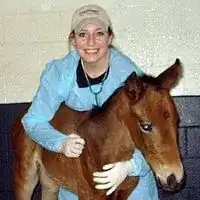 Ryan Corrigan, LVT, VTS-EVNRyan Corrigan is a Licensed Veterinary Technician in California. She received her Bachelor of Science in Veterinary Technology from Purdue University in 2010. She is also a Member of the Academy of Equine Veterinary Nursing Technicians since 2011.
Ryan Corrigan, LVT, VTS-EVNRyan Corrigan is a Licensed Veterinary Technician in California. She received her Bachelor of Science in Veterinary Technology from Purdue University in 2010. She is also a Member of the Academy of Equine Veterinary Nursing Technicians since 2011.
Licensed Veterinary Technician Please have a veterinarian out to look at your lamb and assess it. This is NOT normal behavior for lamb and head pressing is often a clinical sign of a neurologic problem or nutrient deficiency.
Please have a veterinarian out to look at your lamb and assess it. This is NOT normal behavior for lamb and head pressing is often a clinical sign of a neurologic problem or nutrient deficiency.
Warnings
- The lamb will need care at all times, so if you need to leave you need to make sure the lamb is taken care of. Pick someone that has experience with lambs and make sure to tell them about the animals care.⧼thumbs_response⧽
Things You'll Need
- Bottles, plastic or glass
- Rubber nipples
- Colostrum supplements
- Ewe milk replacement
- A place for lamb to sleep
References
About This Article
To raise an orphaned lamb, give the lamb some colostrum, which is the first milk that comes from a mother sheep after birth, since it wasn’t able to get it from its mother and needs it to be healthy. You can give it colostrum from any sheep or cow, and it’s best if the colostrum is fresh or frozen. Otherwise, you can find colostrum from a farm supply store. Using a bottle, feed it 500 milliliters of colostrum over the course of the first day of its life. After the first day, start feeding it around 140 milliliters of lamb milk replacement every 4 hours. Over the course of the first few weeks, gradually increase the amount of milk replacement to 700 milliliters 3 times per day, and continue giving it this amount for 2 weeks. When the lamb is a month old, start weaning it off of the milk replacement and give it grass, hay, and water. In addition to feeding the lamb, make sure it has shelter and plenty of dry bedding like straw to keep it warm at night. For more tips from our Veterinary co-author, like how get your lamb vaccinated, keep reading!
